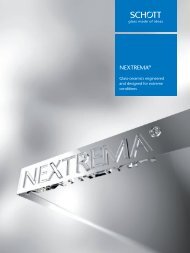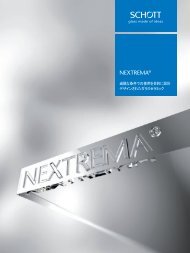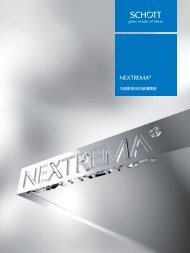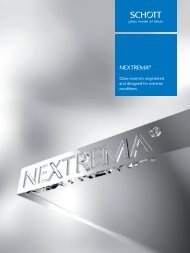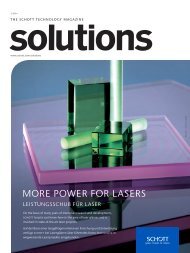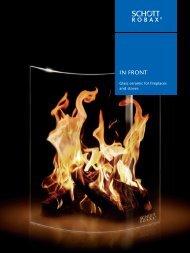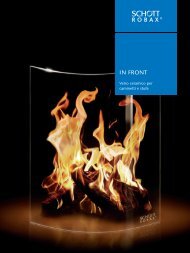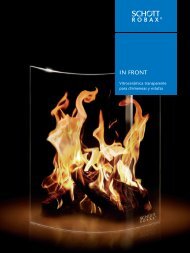SCHOTT Technical Glasses
Apart from its application in optics, glass as a technical material has exerted a formative influence on the development of important technological fields such as chemistry, pharmaceutics, automotive, optics, optoelectronics and information technology. SCHOTT Technical Glasses offers pertinent information in concise form. It contains general information for the determination and evaluation of important glass properties and also informs about specific chemical and physical characteristics and possible applications of the commercial technical glasses produced by SCHOTT. With this brochure, we hope to assist scientists, engineers, and designers in making the appropriate choice and make optimum use of SCHOTT products.
Apart from its application in optics, glass as a technical material has exerted a formative influence on the development of important technological fields such as chemistry, pharmaceutics, automotive, optics, optoelectronics and information technology. SCHOTT Technical Glasses offers pertinent information in concise form. It contains general information for the determination and evaluation of important glass properties and also informs about specific chemical and physical characteristics and possible applications of the commercial technical glasses produced by SCHOTT. With this brochure, we hope to assist scientists, engineers, and designers in making the appropriate choice and make optimum use of SCHOTT products.
Create successful ePaper yourself
Turn your PDF publications into a flip-book with our unique Google optimized e-Paper software.
38<br />
The material properties – especially the gas barrier properties<br />
– are by far superior to polymer films:<br />
Oxygen transmittance rate (cc/[m 2 · 24 hr]) ––><br />
100<br />
10<br />
1<br />
0.1<br />
0.01<br />
30 µm ultra-thin glass (AF 32 ® eco)<br />
100 µm PET<br />
100 µm PEN<br />
20 µm PVA<br />
20 µm PVDC coated PET<br />
0.001<br />
10 –6 10 –5 10 –4 10 –3 10 –2 10 –1 1 10 100 1000<br />
Water vapor transmittance rate (g/[m 2 · 24 hr]) ––><br />
Sample inspection of a thin glass wafer after processing<br />
Fig. 31. Gas barrier properties of ultra-thin glass<br />
8.4 Thin glass processing<br />
Further material properties of the ultra-thin glass types<br />
which are available either on roll or as cut-to-size sheets<br />
property D 263 T eco AF 32 ® eco<br />
CTE 7.2 ppm/K 3.2 ppm/K<br />
alkaline content low no<br />
transformation point 557 °C 715 °C<br />
refractive index 1.5231 1.5255<br />
transmission<br />
λ = 550 nm,<br />
d = 1 MHz<br />
dielectric constant<br />
(at 1 MHz and 20 °C)<br />
loss tangent (tan δ)<br />
(at 1 MHz and 20 °C)<br />
thermal conductivity<br />
(90 °C)<br />
91.7 % 91.9 %<br />
6.7 5.1<br />
0.0061 0.0009<br />
1.06 W/(m · K) 1.06 W/(m · K)<br />
glass type borosilicate alumin-borosilicate<br />
Table 7. <strong>Technical</strong> data of relevant materials<br />
<strong>SCHOTT</strong> offers an entire portfolio of technologies for processing<br />
of thin glass, e.g.<br />
• Cut-to-size for a wide range of wafer and substrate sizes<br />
• Surface refinement by polishing and/or coating<br />
• Structuring of holes or cavities<br />
• Edge treatment options<br />
• Ultrasonic washing<br />
• Clean room packaging<br />
<strong>SCHOTT</strong> thin glass from a down-draw process does not require<br />
any polishing for typical wafer applications due to its<br />
inherently pristine surface quality, low roughness and excellent<br />
geometry like low total thickness variation. Wafers are<br />
directly CNC cut from the mothersheet. Depending on<br />
customer requirements, only edge grinding and ultrasonic<br />
washing are subsequent processing steps. These wafers are<br />
used in high volumes as semiconductor cover glass in wafer<br />
level packaging processes of CMOS image sensors for camera<br />
modules.






